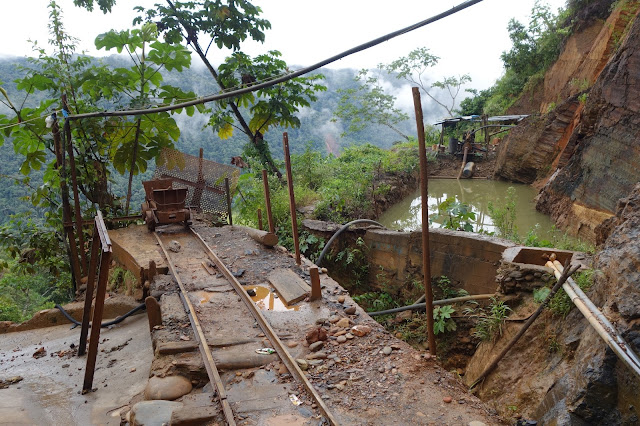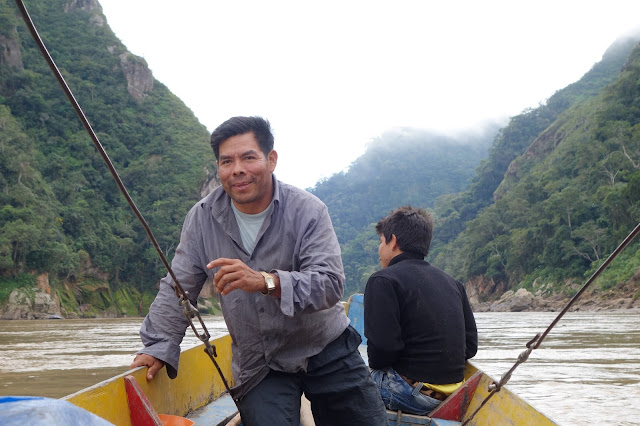Arriving in shiny, touristy Aguas Calientes, the gateway to Machu Picchu, after 4 days in the wilderness was quite a shock. Fortunately I only had to go there to pick up my ticket and next morning at 5 am I was lining up with throngs of other tourists to see the sunrise over Machu Picchu. Despite all the tourists, I found it a magnificent and majestic place and well worth the visit.
On the way back to Cuzco, I stopped off to visit some more Incan ruins in the town of Ollantaytambo. Smaller and more relaxed than Machu Picchu, it was a good chance to check out some of the incredible stone masonry of the Incans.
My time in South America is slowly coming to an end. It's been a wonderful experience but I'm feeling a little bit travel-weary after so many months on the road. Therefore, I've decided to return to Sucre in Bolivia a little bit earlier than planned and take some more Spanish lessons before I depart for London on 24 July.
The view hiking from Mollepata to Soraypampa. It feels good to be hiking to Machu Picchu.
A friendly guy by his home.
Breakfast time shortly before Soraypampa. I met a Canadian guy called Chris and we hiked most of the day together.
Great flat hiking for beside a canal all the way to Soraypampa. Salkantay (6271 m) is coming into view on the right.
I pushed on to the pass at 4600 m, This is a view back down the valley towards Soraypampa.
On the pass.
Pack horses for tourists on guided hikes are continually returning to Soraypampa.
Another top camping spot, about 500 m below the pass.
I carried this trek'n'eat for my whole South American trip as an emergency meal. Time to eat it.
Heading further down the valley the next morning.
A day later, and the climb to the Incan ruins at Llactapata passes through a coffee growing region. A veritable paradise, where all sorts of fruit grow in abundance.

Bananas, avocados, citrus, tree tomatoes, sugar cane, passionfruit and more...
Up through the subtropical jungle.
I reached the railway station called Hidroelectrica, and from there it was another 2 hours of hiking to the entrance gate of Machu Picchu. A long day.

The deep valleys near the entrance gate of Machu Picchu add to the feeling of isolation.
Before the sun strikes Machu Picchu, it strikes the surrounding peaks first.
Machu Picchu at sunrise.
The Inca Bridge, currently a bridge to nowhere.

Machu Picchu's isolated location in the mountains at 2453 m between Altiplano and jungle meant it remained undiscovered by the Conquistadors. The Incas abandoned it during the second half of the 16th century and it only became well-known in the West after Hiram Bingham's expedition in 1911. This photo was taken from near the Sun Gate.
Some details are pretty special, like the kingfisher in stone.
The astronomical observatory.
The Temple of the Sun is a good example of some of the incredible stone masonry perfected by the Incas. The granite stone was ideal for shaping.
The view hiking from Mollepata to Soraypampa. It feels good to be hiking to Machu Picchu.
A friendly guy by his home.
Breakfast time shortly before Soraypampa. I met a Canadian guy called Chris and we hiked most of the day together.
Great flat hiking for beside a canal all the way to Soraypampa. Salkantay (6271 m) is coming into view on the right.
I pushed on to the pass at 4600 m, This is a view back down the valley towards Soraypampa.
On the pass.
Pack horses for tourists on guided hikes are continually returning to Soraypampa.
Another top camping spot, about 500 m below the pass.
I carried this trek'n'eat for my whole South American trip as an emergency meal. Time to eat it.
Heading further down the valley the next morning.
A day later, and the climb to the Incan ruins at Llactapata passes through a coffee growing region. A veritable paradise, where all sorts of fruit grow in abundance.

Bananas, avocados, citrus, tree tomatoes, sugar cane, passionfruit and more...
Up through the subtropical jungle.

The deep valleys near the entrance gate of Machu Picchu add to the feeling of isolation.
Before the sun strikes Machu Picchu, it strikes the surrounding peaks first.
Machu Picchu at sunrise.
The Inca Bridge, currently a bridge to nowhere.

Machu Picchu's isolated location in the mountains at 2453 m between Altiplano and jungle meant it remained undiscovered by the Conquistadors. The Incas abandoned it during the second half of the 16th century and it only became well-known in the West after Hiram Bingham's expedition in 1911. This photo was taken from near the Sun Gate.
Some details are pretty special, like the kingfisher in stone.
The astronomical observatory.
The Temple of the Sun is a good example of some of the incredible stone masonry perfected by the Incas. The granite stone was ideal for shaping.


































































